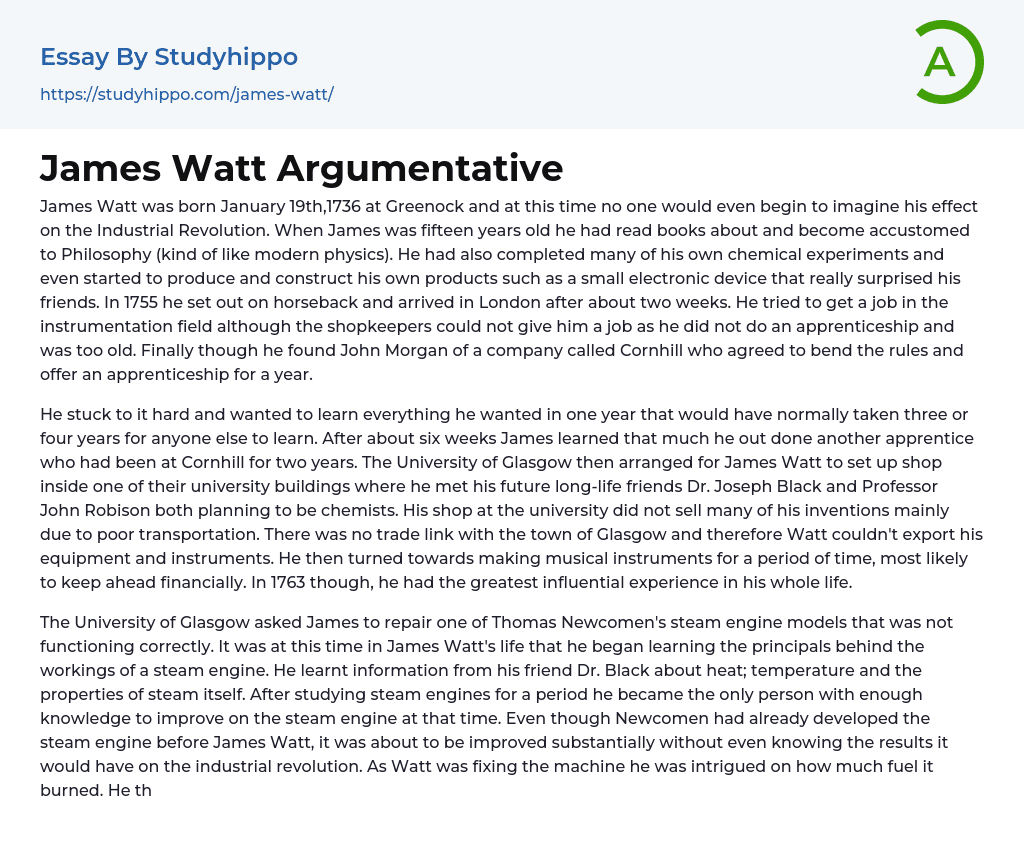Born on January 19th, 1736 in Greenock, James Watt had a notable influence on the Industrial Revolution. At fifteen years old, he embarked on the study of Philosophy, akin to present-day physics. Additionally, he engaged in diverse chemical experiments and crafted remarkable inventions that astounded his peers, such as an electronic apparatus. In 1755, he embarked on a two-week journey to London by horseback with the aim of securing employment opportunities related to instrumentation. Yet, encountering hurdles due to his lack of apprenticeship experience and advanced age, he encountered challenges in finding work among local shopkeepers.
Finally, John Morgan from Cornhill offered an apprenticeship to James Watt, despite the rules. James was determined to learn everything in one year, which would typically take others three or four years. Within six weeks, he surpassed another apprentice who had been at Cornhill for two y
...ears. Subsequently, the University of Glasgow allowed James to establish his workshop in one of their buildings where he befriended Dr. Joseph Black and Professor John Robison, both aspiring chemists. However, his inventions did not sell well at the university due to inadequate transportation.
Watt faced a lack of trade connection between Glasgow and the town, hindering his ability to export machinery and instruments. Consequently, he temporarily shifted his focus to crafting musical instruments in order to maintain financial stability. Nonetheless, his life took a significant turn in 1763 when the University of Glasgow approached him with an opportunity. They asked Watt to repair a malfunctioning steam engine model designed by Thomas Newcomen. This experience proved pivotal as it initiated Watt's journey into understanding the fundamental principles behind steam engine operation.
After receiving information from Dr
Black, a friend of his, he gained knowledge about heat, temperature, and the characteristics of steam. After extensively studying steam engines, James Watt became the only person with enough expertise to improve the steam engine of that time. Despite Newcomen's prior development of the steam engine, James Watt was close to making significant advancements to it without realizing how it would greatly impact the industrial revolution. While fixing the machine, Watt became intrigued by its excessive fuel consumption. As a result, he started thinking about ways to reduce fuel usage and discovered that it primarily stemmed from heating and cooling pistons and other metal parts which consistently required more heat.
James Watt improved the steam engine by adding an insulated main cylinder, which maintained a constant high temperature and reduced fuel consumption by about 75%. He also developed a condenser that recycled five out of six units of wasted steam by converting it back into water. Additionally, Watt skillfully incorporated a leather washer into the piston cylinder to ensure a tight seal and prevent steam leakage, a problem that had existed previously. In 1767, Watt formed a partnership with Dr. Roebuck, an acquaintance he had at that time. Dr.
Roebuck, who paid off Watt's 1000 debt and supported his experiments, was declared two-thirds the inventor of the improved steam engine in return. On January 5th, 1769, the same day Watt acquired his first patent, Arkwright also obtained a patent for his 'Spinning-Frame'. Watt successfully ensured that his name was associated with the new steam engine, thanks to Dr. Roebuck's assistance.
Newcomen's initial steam engines were employed for the purpose of pumping water out from the mines in close
proximity. However, by 1783, most of Newcomen's engines had been replaced by those created by Watt. In September 1769, Watt completed a sizable steam engine; nevertheless, he himself did not give it his approval and regarded it as a 'clumsy job'. The recently introduced condenser was not functioning efficiently, and there were issues with the cylinder's shape which resulted in leakage and steam escaping. Simultaneously, Roebuck began retiring while Matthew Boulton, who was only seventeen years old at the time, left school to join his father in the family business. Ultimately after his father's demise, Matthew Boulton assumed control of the business.
Roebuck was in contact with Boulton regarding Watt's communication as well.
- Energy Development essays
- The elements essays
- Voltage essays
- Solar Energy essays
- Nuclear Energy essays
- Alternative Energy essays
- John Locke essays
- 9/11 essays
- A Good Teacher essays
- A Healthy Diet essays
- A Modest Proposal essays
- A&P essays
- Academic Achievement essays
- Achievement essays
- Achieving goals essays
- Admission essays
- Advantages And Disadvantages Of Internet essays
- Alcoholic drinks essays
- Ammonia essays
- Analytical essays
- Ancient Olympic Games essays
- APA essays
- Arabian Peninsula essays
- Argument essays
- Argumentative essays
- Art essays
- Atlantic Ocean essays
- Auto-ethnography essays
- Autobiography essays
- Ballad essays
- Batman essays
- Binge Eating essays
- Black Power Movement essays
- Blogger essays
- Body Mass Index essays
- Book I Want a Wife essays
- Boycott essays
- Breastfeeding essays
- Bulimia Nervosa essays
- Business essays
- Business Process essays
- Canterbury essays
- Carbonate essays
- Catalina de Erauso essays
- Cause and Effect essays
- Cesar Chavez essays
- Character Analysis essays
- Chemical Compound essays
- Chemical Element essays
- Chemical Substance essays




